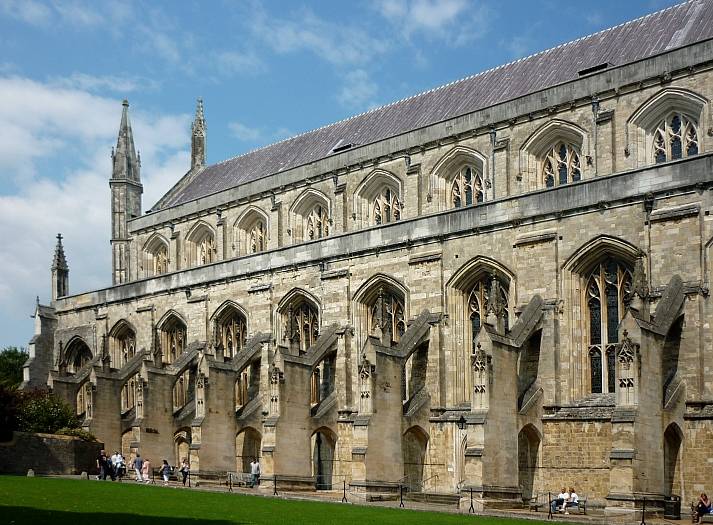
Winchester Cathedral, Victorian restoration under the Cathedral's architectural surveyor, John Colson (1820-1895), with interior work by Sir George Gilbert Scott and others. Photograph and text by Jacqueline Banerjee, 2009. [You may use this image without prior permission for any scholarly or educational purpose as long as you (1) credit the photographer and (2) link your document to this URL in a web document or cite the Victorian Web in a print one.]
Despite its lack of "strong vertical accents," this cathedral is impressively large, the longest not only in England but in Europe as a whole (Pevsner and Lloyd 661). It has an ancient history: a minster church was first built at Winchester in the mid-seventh century, soon after which the town became the centre of Wessex and, indeed, of the Anglo-Saxon kingdom. The cathedral subsequently erected here, using pleasantly light-coloured stone from the Isle of Wight as its main material, was consecrated in 1093. The usual pattern of building and rebuilding followed, with elements of older work remaining alongside the newer. For example, the choir still has its fourteenth-century wooden choir stalls, with some delightful medieval carving in the panelling (such as this falconer, the sort of thing that must have fired William Burges's imagination); but the open-work choir screen dates from 1875 and is by Sir George Gilbert Scott. Although Scott based his designs on earlier ones, his work here was criticised at the end of the period — the choir screen partly, it seems, for "the pallor of its wood" (which must have darkened now), and his monument to Bishop Wilberforce in the south transept, with its Gothic canopy, for being "out of place in its Norman surroundings" (Sergeant 50, 68). Apart from these features and a number of other monuments, the main Victorian work in the cathedral was the restoration of the Great Screen, a collaborative effort involving such big names as G. F. Bodley, who designed the crucifix; Thomas Nicholls (William Burges's trusted sculptor), who sculpted eight of the central statues, including the Virgin Mary; and the London firm of Farmer & Brindley, which executed the crucifix. Amongst the grand total of fifty-six statues is one of Queen Victoria herself. The Great Screen was finally dedicated in March 1899, several years after John Colson's death. This part of the restoration was controversial too, but no one would now call it "a flagrantly artless device" (qtd. in Sergeant 61); on the contrary, it is widely recognised as a "magnificent structure" (Brandwood 11). Winchester Cathedral has a special place in literary history because Jane Austen, who died nearby, was buried here: her gravestone can be seen on the flooring of the north side of the nave.
Other Views and Related Material
- West front
- Interior, showing the Great Screen
- Detail of Great Screen (St Hedda, by Boulton of Cheltenham)
- Interior, showing Sir George Gilbert Scott's choir screen
- Scott's Choir screen
- Detail of wood carving in choir
- Jane Austen's gravestone in the nave
- Monument to Bishop Samuel Wilberforce
- Adrian Jones's Memorial in nave to Charles Berkeley Pigott, by Adrian Jones
- Monument to Bishop Brownlow North
References
Brandwood, Geoff. "'Unlucky Experiments in Statues': Restoring the Winchester Great Screen." Ecclesiology Today, Issue 31 (May 2003): 3-13.
Pevsner, Niklaus, and David Lloyd. Hampshire and the Isle of Wight. The Buildings of England series. London: Penguin, 1967.
Sergeant, Philip W. The Cathedral Church of Winchester: A Description of Its Fabric and a Brief History of the Episcopal See. London: George Bell, 1903.
Last modified 30 November 2009